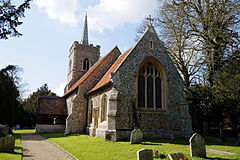Human settlement in England
| Abbess Roding | |
|---|---|
 St Edmund's Church, Abbess Roding St Edmund's Church, Abbess Roding | |
 | |
| OS grid reference | TL571113 |
| Civil parish | |
| District | |
| Shire county | |
| Region | |
| Country | England |
| Sovereign state | United Kingdom |
| Post town | ONGAR |
| Postcode district | CM5 |
| Dialling code | 01279 |
| Police | Essex |
| Fire | Essex |
| Ambulance | East of England |
| UK Parliament | |
| 51°46′44″N 0°16′33″E / 51.7788°N 0.2759°E / 51.7788; 0.2759 | |
Abbess Roding is a village and former civil parish, now in the parish of Abbess, Beauchamp and Berners Roding and the Epping Forest District of Essex, England. The village is included in the eight hamlets and villages called The Rodings. It is in west Essex, 5 miles (8 km) north from Chipping Ongar, and 9 miles (14 km) west from the county town of Chelmsford. In 1931 the parish had a population of 169.
History
According to A Dictionary of British Place Names, Roding derives from "Rodinges", as is listed in the Domesday Book and recorded earlier as such at c.1050, with the later variation 'Roinges Abbatisse' recorded in 1237. The 'Abbess' refers to the manorial possession by a man called 'Aitrop' held under the ownership of the Abbess of Barking Abbey.
In the Domesday account Abbess Roding is listed as in the Hundred of Ongar. The manor held 18 households, seven villagers, two smallholders, five slaves, and one freeman, with 2 lord's plough teams, 3.5 men's plough teams, 20 acres (0.08 km) of meadow, and a woodland with 20 pigs. In 1066 there were 10 cattle, 40 pigs, 100 sheep and a cob. In 1086 there were 14 cattle, 60 pigs, 131 sheep, and three cobs. Before the Conquest, lordship was held by Wulfmer of Eaton Socon; after given to Eudo Dapifer who was also Tenant-in-chief to William the Conqueror. A further source, the Domesday Book: A Complete Translation, gives a Domesday record of Abbess Roding being held by Geoffrey Martel as part of the land of Geoffrey de Mandeville.

Other traditional names for the village and its previous parish were 'Abbott's Roothing' or 'Abbots Roding'. It was in the Hundred of Ongar. At the Dissolution, Henry VIII sold the Barking Abbey's estate to Robert Chertsey. In 1882 Abbess Roding was in the Ongar Union—poor relief provision set up under the Poor Law Amendment Act 1834 —and part of the Rural Deanery of Ongar. The registers of the church of St Edmund date to 1560. The church, restored in 1867, had attached an 1882 benefice of a rectory with residence, in the gift of and held by Rev. Lawrence Capel Cure of Balliol College, Oxford. There also existed a Congregational chapel. Sir Henry Selwin-Ibbetson, Bt was Lord of the Manor and principal landowner. There was 1,393 acres (5.6 km) of parish land supporting a population of 237. Crops grown at the time were chiefly wheat, barley and beans, on a heavy soil with a clay subsoil. Parish occupations included seven farmers, a beer retailer, and the licensee of The Anchor public house.
On 1 April 1946 the parish was abolished to form "Abbess Beauchamp and Berners Roding".
Governance
The village is in the parliamentary constituency of Brentwood & Ongar. The village is locally served by Abbess, Beauchamp and Berners Roding Parish Council.
Notable people
- Sir Gamaliel Capell - Member of Parliament, owned Rookwood Hall.
- John Thurloe - secretary to the council of state in Protectorate England and spymaster for Oliver Cromwell, was born here.
References
- "Population statistics Abbess Roding CP/AP through time". A Vision of Britain through Time. Retrieved 30 June 2023.
- Mills, Anthony David (2003); A Dictionary of British Place Names, Oxford University Press, revised edition (2011), p.392. ISBN 019960908X
- Abbess Roding Archived 23 November 2007 at the Wayback Machine
- "Abbess Roding", Open Domesday, University of Hull. Retrieved 9 February 2018
- Williams, Ann; G H Martin (24 September 2004). Domesday Book: A Complete Translation. London: Penguin. pp. 1012, 1303. ISBN 978-0-14-143994-5.
- Kelly's Directory of Essex 1882 pp.245-247
- "Relationships and changes Abbess Roding CP/AP through time". A Vision of Britain through Time. Retrieved 30 June 2023.
- "Abbess, Beauchamp and Berners Roding", Abbess, Beauchamp and Berners Roding Parish Council. Retrieved 10 February 2018
- "Abbess, Beauchamp and Berners Roding Parish Council - Key Contacts". www.eppingforestdc.gov.uk. Archived from the original on 5 June 2011. Retrieved 21 January 2007.
- "CAPELL, Sir Gamaliel (1561-1613), of Rookwood Hall, Abbess Roding, Essex". History of Parliament Online. Retrieved 2 March 2019.
- Venning, Timothy (3 January 2008). "Thurloe, John". Oxford Dictionary of National Biography (online ed.). Oxford University Press. doi:10.1093/ref:odnb/27405. (Subscription or UK public library membership required.)
External links
![]() Media related to Abbess Roding at Wikimedia Commons
Media related to Abbess Roding at Wikimedia Commons
- Abbess Roding Church on Essex Churches website
- Map of Abbess Roding conservation Area
- Abbess, Beauchamp and Berners Roding Parish Council official website including Abbess Roding description. Retrieved 10 February 2018
| Unitary authorities | |
|---|---|
| Boroughs or districts | |
| Major settlements (cities in italics) |
|
| Rivers | |